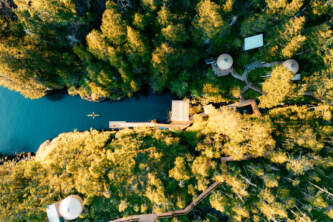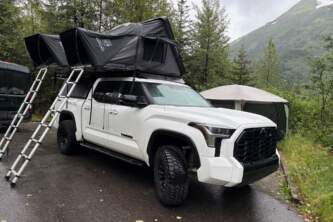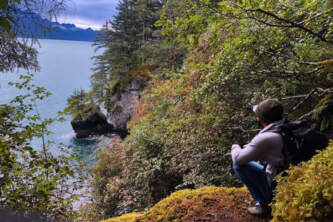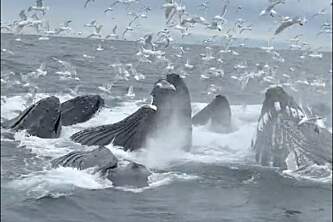My Screw Ups on the 26 Glacier Cruise

By Bob Kaufman
Founder, Alaska.org
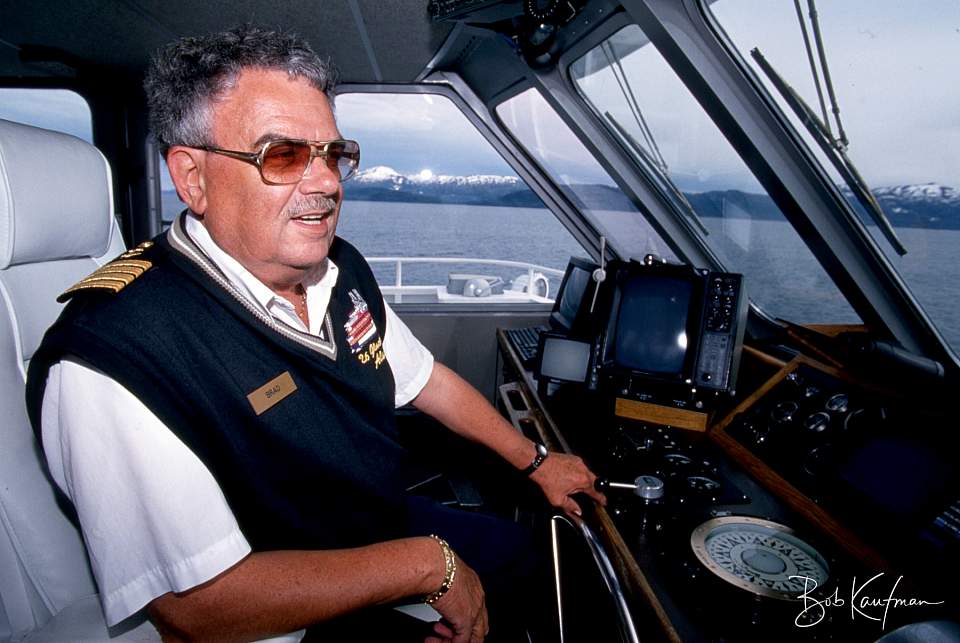
My good friend Brad Phillips in 1995, at the helm--where he loved to be.
Getting access to places is hard in Alaska. Nothing better in Alaska than being friends with a bush pilot or someone who owns a boat. Even better, a boat that goes every day, 90 miles into Prince William Sound, with enough room to carry kayaks and all the camping gear in the world.
Brad Phillips, the founder of the 26 Glacier Cruise, was one of my first relationships in Alaska. I worked out of his office, and he would do anything for me. His tours offer an ingenious way to see coastal marine wilderness—and an extraordinary platform for photographing calving glaciers.
As I got more into kayaking and taking back country trips, I approached Brad about the idea of letting me bring my gear on the 26 Glacier Cruise and dropping me off out in the middle of PWS.
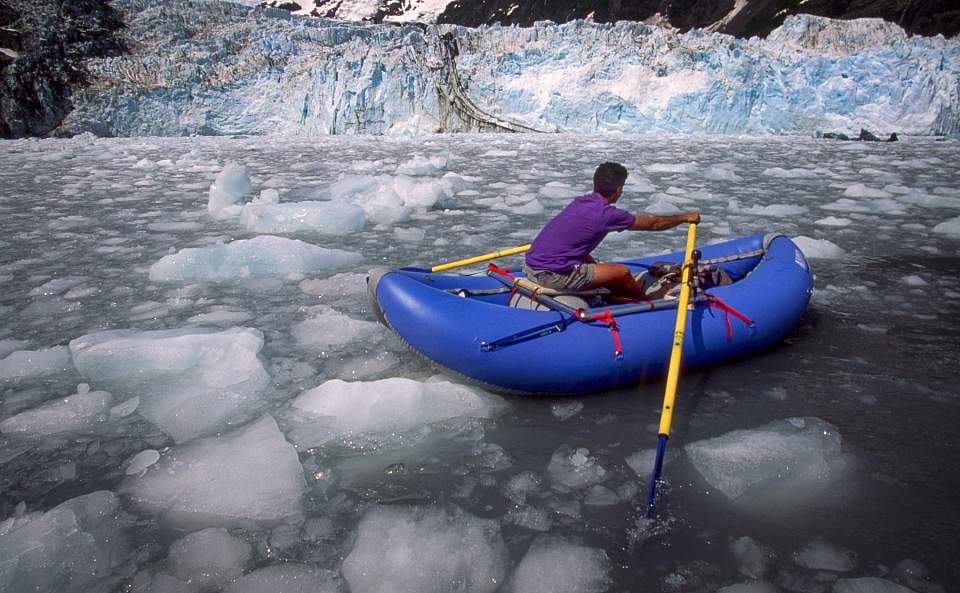
With my friend John Wanamaker on one of my first filming trips. After trying to row that oar boat through miles of heavy icebergs, we learned our lesson, and never brought it out into the Sound again.
I assured him that I would have my gear organized and be ready to push off, so that the boat would only need to stop for less than five minutes.
Brad agreed to give it a try. The first time, I got dropped off in Surprise Inlet. Not only was it not a nuisance, everyone on the boat was talking about the kayakers who were going into the wilderness. We discovered that I was part of the attraction! The next time I got dropped off, I was embarrassed to hear the tour guide over the PA system talking about what I was about to do.
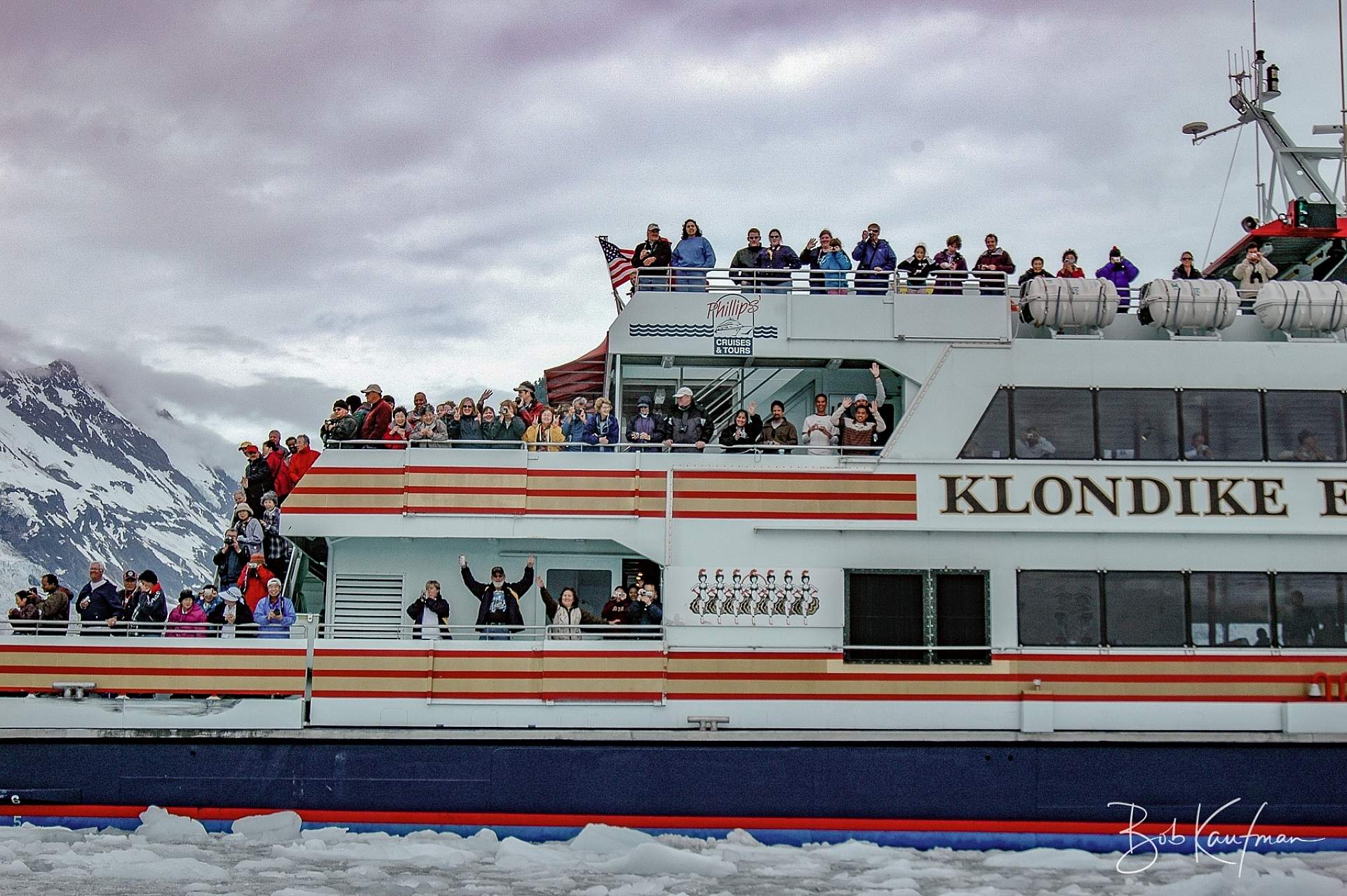
I photographed this from my kayak after getting dropped off from the boat. Everyone was waving me goodbye and wishing me good luck. I was a little embarrassed feeling like a spectacle.
The Early Years
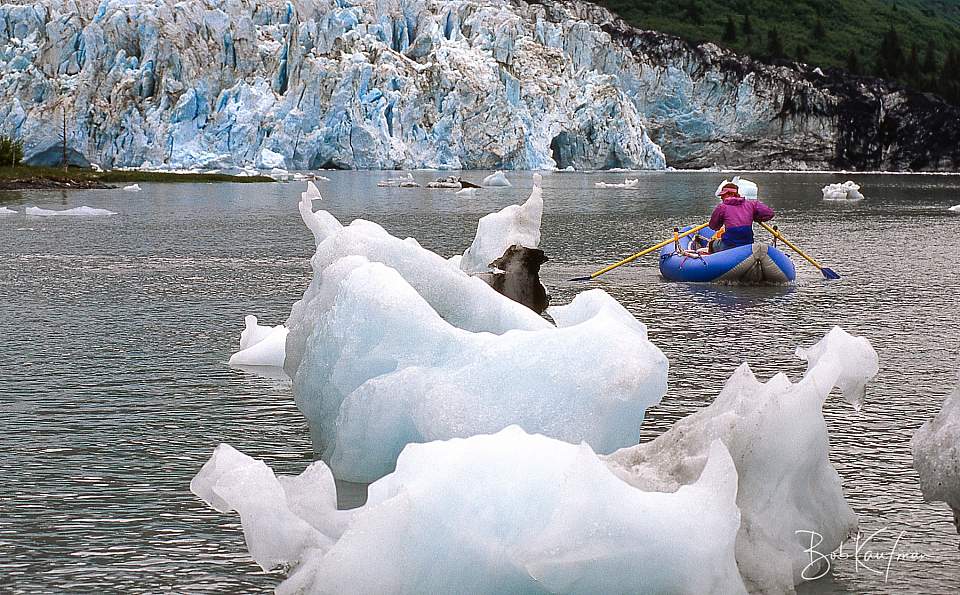
With Kip O'Kelly at Bryn Mawr Glacier in 1996. Getting dropped off here did not work out so well. There was nowhere to camp--and scant filming potential. But once the boat left, this was to be our home for the 24 hours until it returned. The saving grace was being here with Kip, a hard worker who would unhesitatingly lug any piece of gear and help me set up any shot I was trying to get. At the time, Kip earned his income by backpacking a portable sawmill to different cabin sites in the wilderness of Kachemak Bay then milling wood planks for his client's cabin.
Thus was born one of the great perks of my career in the tourism business. Over the years, I got dropped off in at least a half-dozen locations: Harriman Fjord, memorialized by the famous Harriman Expedition in the 1890s; Bryn Mawr Glacier, one of many glaciers in PWS that Harriman and John Muir named after eastern colleges; Barry Arm, where three large glaciers converge, spawning gorgeous icebergs just in front of a great camping spot, the Black Sand Beach.
Each time, the boat would stop to let me off. They would hand me a radio to communicate with them for my return trip. During a 30-minute window on the pick-up day, I would paddle out to the middle of the bay to a prearranged spot and be ready the moment the boat came by, without delaying the cruise.
Strike One
Paying for a drop-off in PWS is expensive. So a few of my ne’er-do-well friends wanted to get in on the action. One time, I arranged for one of them to guide my brother on a multi-day trip into PWS and asked Brad if he would mind dropping them off. He cheerfully agreed. Unfortunately, their camp got washed out on their last night, leaving them in disarray the next morning. As a result, they were not on time to meet the cruise for the pickup. After that, Brad’s staff pressured him to end the perk. Sadly, it appeared to be over forever.
Strike Two
But Brad had my back. He told me he had purchased a motorboat that he wanted to use in the Sound, but was currently staged at Big Lake. He told me he had a boat trailer, and I was welcome to use the boat if I drove up and picked it up. This was even better than the last perk. So I invited some friends from Los Angeles to come up for a four-day trip into the Sound.
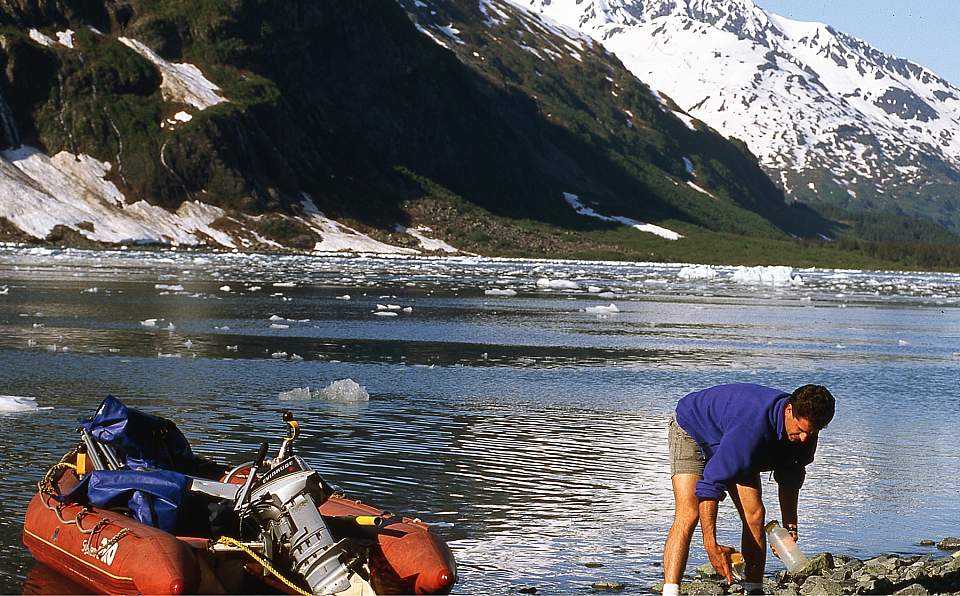
The powered Zodiac became my preferred craft for filming. It was easy and fast to get around and it provided a modicum of stability when shooting video.
When he gave me the final instructions, Brad said I give you this boat under four conditions: 1) Don’t let my wife know about the boat; that’s why I keep it at Big Lake, 2) Don’t hit an iceberg, 3) Don’t get grounded at low tide, and 4) Don’t run out of gas. On the last two points, he emphasized how expensive and impractical it would be to tow the boat back to Whittier from some distant point in the Sound. Of course, none of those things will happen, I assured him.
And when we got on that boat, my eyes glued to the fuel gauge, and when I saw how little it used, I became relieved. No problem. We cruised about 40 miles to Surprise Inlet, watched the glacier calf. We cruised around to Harriman Fjord, camped at the head of the Bay. The weather was beautiful, and trip had to end too soon.
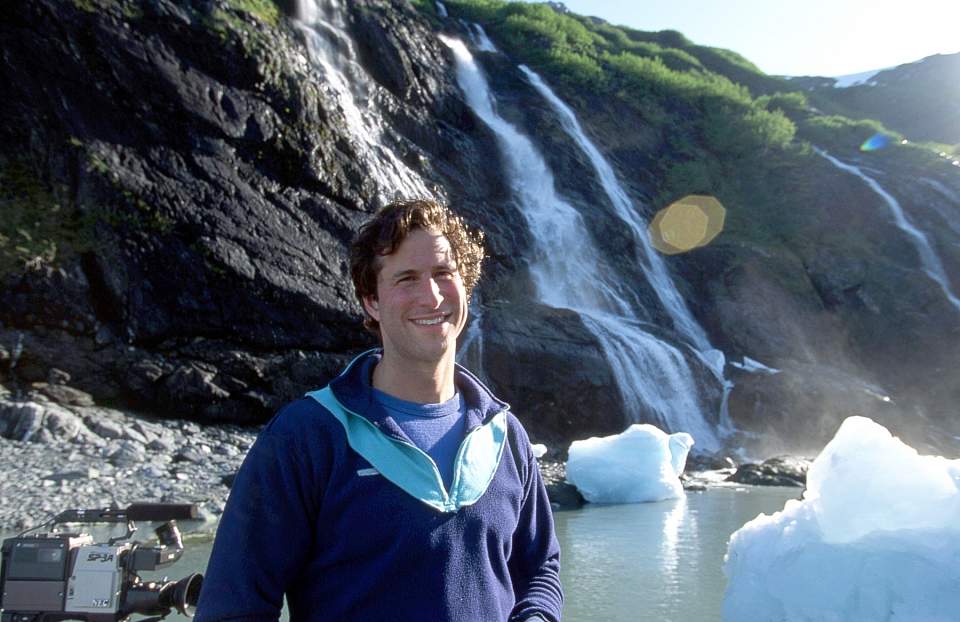
One of my first filming missions into Prince William Sound. I recall renting this beast of a camera for the entire summer for a few hundred dollars.
We started motoring back toward Whittier. By the time we’d exited Harriman’s bay, we’d used only a quarter tank of fuel. No problem! But then, something puzzling occurred. After cruising another 20 minutes down the fiord, we were down to half of a tank. And then a quarter. I became very worried—and for good reason. When the engine ran out of gas, we were still more than 30 miles from Whittier.
I knew the 26 Glacier Cruise would be passing our location within an hour. It was a hot, sunny day. So we made the best of our situation by taking dips into the ocean and just waiting. Still, I was mortified what Brad would think. The big boat arrived soon enough. I flagged them down and sheepishly explained our predicament. Hours later, a rescue boat came from Whittier with 30 gallons of fuel—and a $500 drop-off charge!
Strike Three
I was so embarrassed that I wouldn’t even allow the thought of asking Brad for another drop-off to enter my mind for years. Then, in 2006, I decided that I wanted to get some great glacier calving footage for Alaska Channel. The best way would be to get dropped off in the Sound so I could set up my tripod on the ground and wait for hours. I knew the perfect rock—an islet that had been recently been exposed after being buried by ice for millennia. It was deep in Barry Arm, with a perfect high perch to set up a tripod and wait for glacial action. Most importantly, it was a safe distance from the face of the glacier.
If I could just get someone to take me to Black Sand Beach. …
Not only was I excited when Brad said yes, but so was his crew. They, too, had gotten in on the perk, and it seemed the doors were open again. This time, I brought along a video intern. He would help me film and provide support. We got dropped off in the afternoon, camped for the night and prepared to shoot video after breakfast.
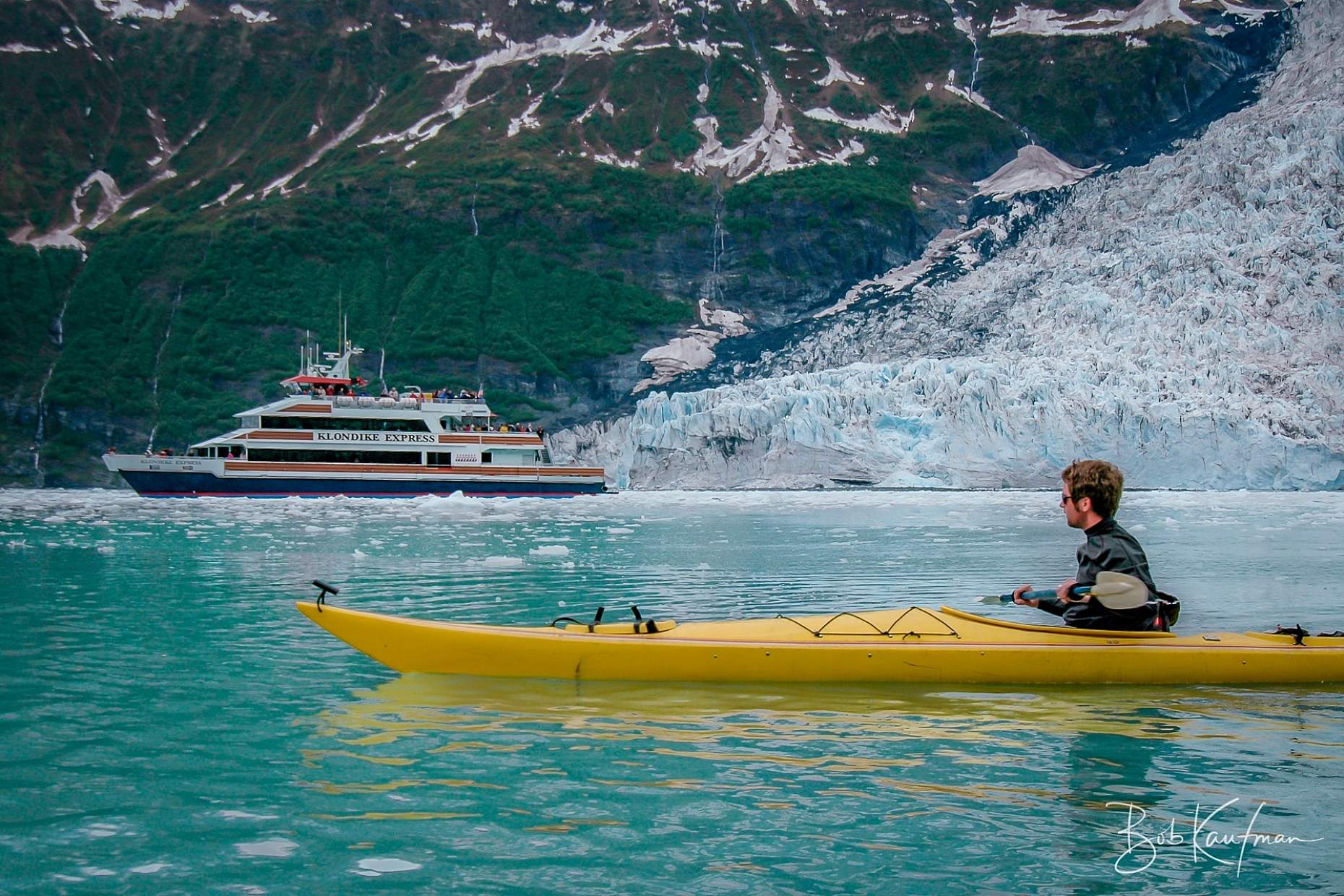
From our position on shore, ready to launch, the rock did appear to be awfully close to the glacier. Scarily close. In fact, I was pretty sure that no one had ever tried to land on that islet before. Still, I was game. Not the intern. He announced that he just didn’t feel comfortable paddling over there with me.
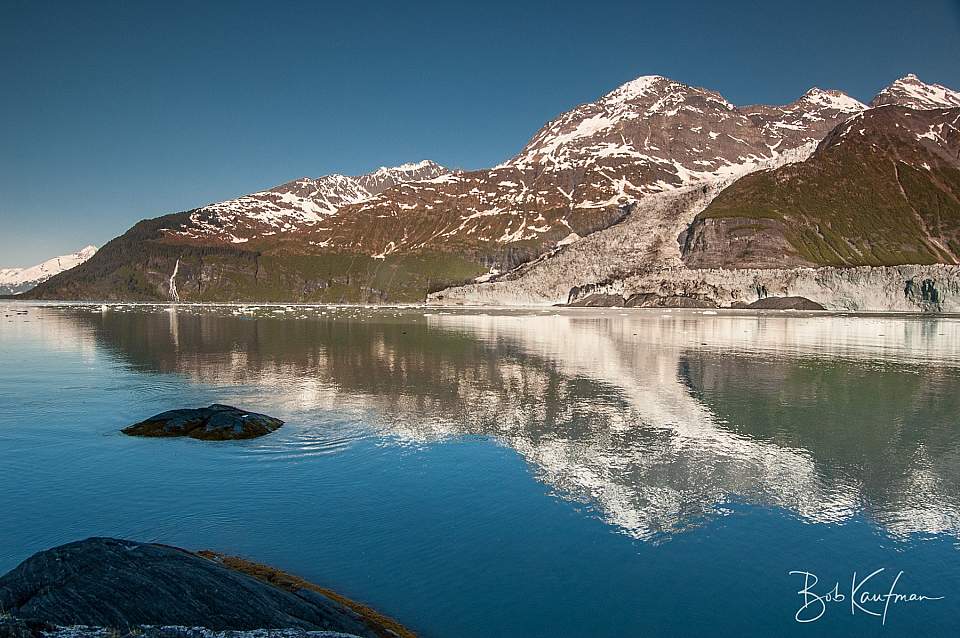
The view from our campsite. You can see the rock up against the glacier in the distance upon which I would mount my ill-fated filming mission the next morning.
The water was placid but filled with gobs of little icebergs. I knew what I was doing. What could go wrong?
So I paddled through the ice to the rock alone. I knew the tide would be rising, so I dragged my boat up the slope to a spot that I believed was at least 20 feet above the waterline. Then I climbed another hundred feet to the summit and got to work. I set up my tripod, got the camera settings right, and waited patiently for something to happen. My eyes were glued to the glacier, looking for a sign that a calving event was about to occur. I knew I had only three hours before needing to paddle back to camp and get ready for the pickup.
The glacier rumbled with what sounded like distant thunder. The peals became louder and more frequent. I sensed something big was coming. … And then it happened: A quarter mile of glacier ripped free and plunged into the sea with such force that it sent a huge wave cascading towards me across the bay. This was the calving event I had wanted to see. The splash, the march of rolling waves, the violence of the icebergs rocking in the water. It was engrossing, and I captured thrilling footage of the event.
After the seas calmed, I packed up my gear and carefully down-climbed the slippery rock to the beach. Mission accomplished.
My kayak was gone.
I immediately understood my predicament. I was stranded on a rock in the middle of a remote fiord in a far corner of PWS—not only without a paddle, but without a boat!
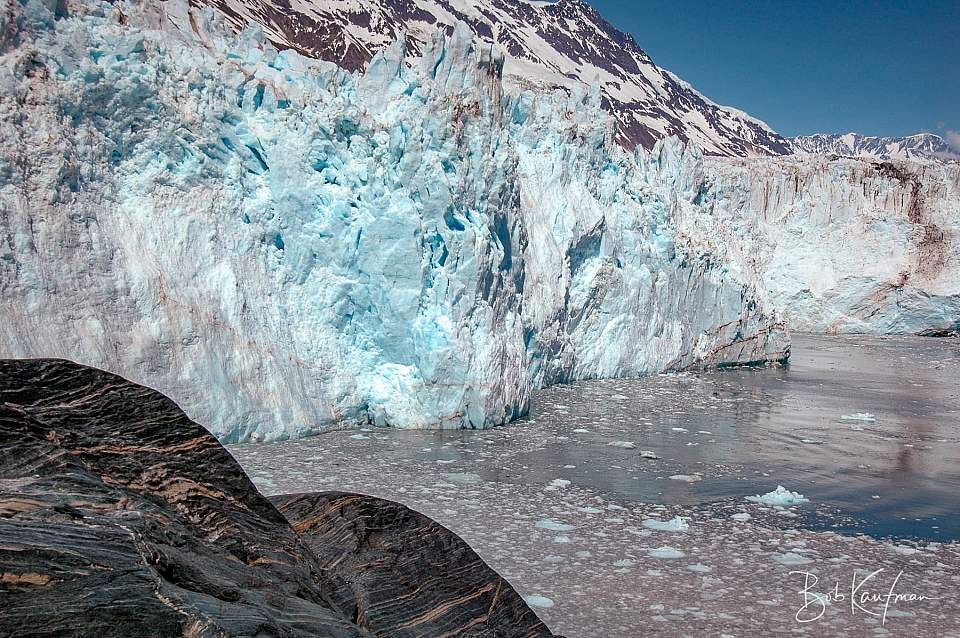
The view from the top of the rock.
I desperately scanned the ocean, hoping the kayak would be a few yards offshore, close enough to swim for it. My eyes found its yellow shape a good quarter mile out. It was drifting toward the face another glacier. I knew I had to retrieve it before it got too close. But what could I do? It was much too far away to try swimming in such cold water.
I hatched a plan to radio my intern on Black Sand Beach, a mile away. Would he even still have his radio on? I pulled it out and transmitted. I was so relieved to hear his voice, and I got right to the point:
“I know you don’t feel comfortable paddling, but I really, really need your help.”
I asked him to paddle his kayak to my location. I would then use his kayak to retrieve mine, tow it back to the rock, and both of us would paddle back to camp together.
God bless him, he said he would try. From across the immense bay, I watched him drag his kayak to the shoreline and start to paddle in my direction through the floating ice. As his boat drew closer, I started to feel less alone. Then the kayak stopped. And stayed still. Was he fiddling with the spray skirt? Re-organizing his foot pedals? We didn’t have much time before the 26 Glacier Cruise came for the pickup, and I became anxious.
I called him on the radio: “How you doing?”
My intern told me he was having a panic attack. He could paddle no further.
I thought a very bad word.
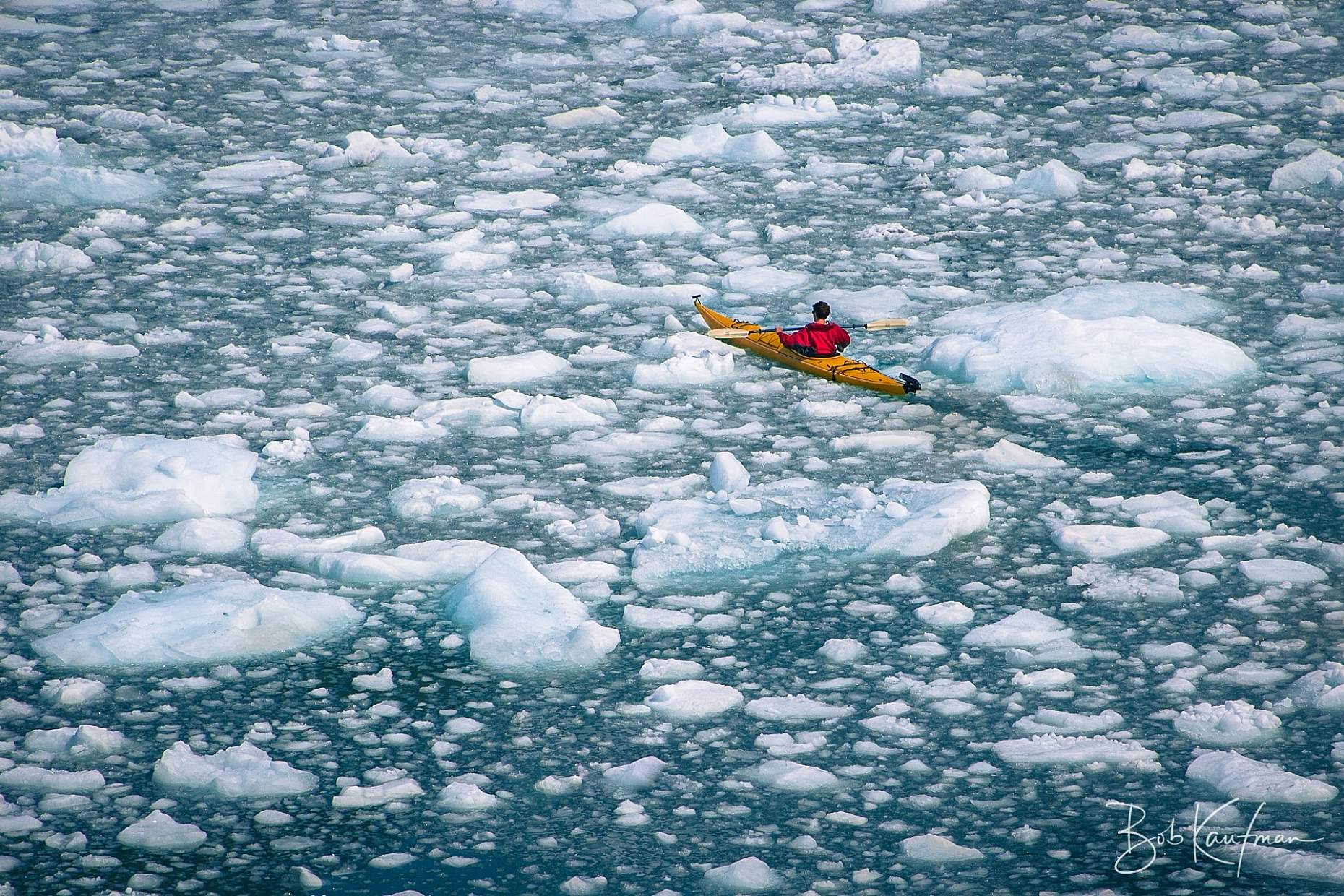
What else could I do? I instructed him to return to shore and be safe. And then I waited for the 26 Glacier Cruise to appear—and that dreaded radio call I was going to have to make to the captain.
The rescue craft they dispatched from Whittier motored into view about three hours later. It grew larger on the horizon. Finally, it pulled up to my rock. I could see in the boat captain’s furrowed brow that he was not happy to be on this mission, and that a lecture was coming. The guy thought I was an idiot. There was no point explaining to him that I usually do know what I’m doing, but that a massive calving event—unforeseeable, in fact—had unexpectedly washed my kayak away! (At least that was my story.)
That trip became my last drop-off from the 26 Glacier Cruise. Sadly, I believe my adventure ended drop-offs for everyone, for which I feel really bad. Only a few years later, Brad sold the 26 Glacier Cruise. So now, when I want to go kayaking or camping in Prince William Sound, I hire a water taxi to perform the service.
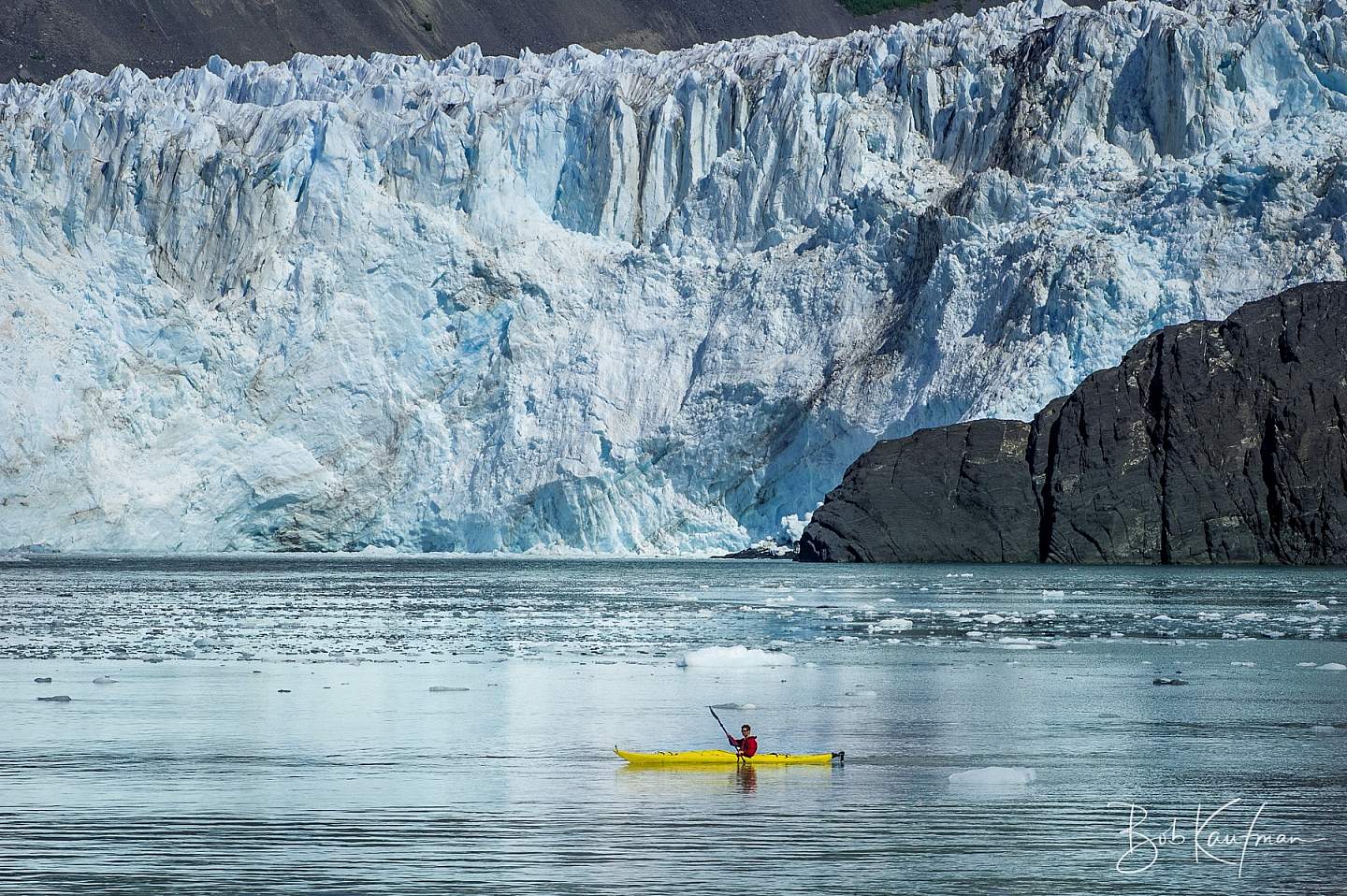
The immensity of the glaciers and walls in Prince William Sound is hard to overstate.
But I still take the 26 Glacier Cruise when I have guests or feel the urge to photograph the glaciers. I love waiting on deck in front of Surprise for calving, studying the craggy face of Harriman (where I’ve camped many times and even landed my airplane,) and venturing into remote College Fjord on such a fast, comfortable boat. I love it all—the harbor seals and sea otters, the kittiwake rookery across from Whittier, eating lunch as the scenery unfolds. It remains an amazing craft that visits amazing places.
Just don’t ask the captain to put you ashore with a kayak.

